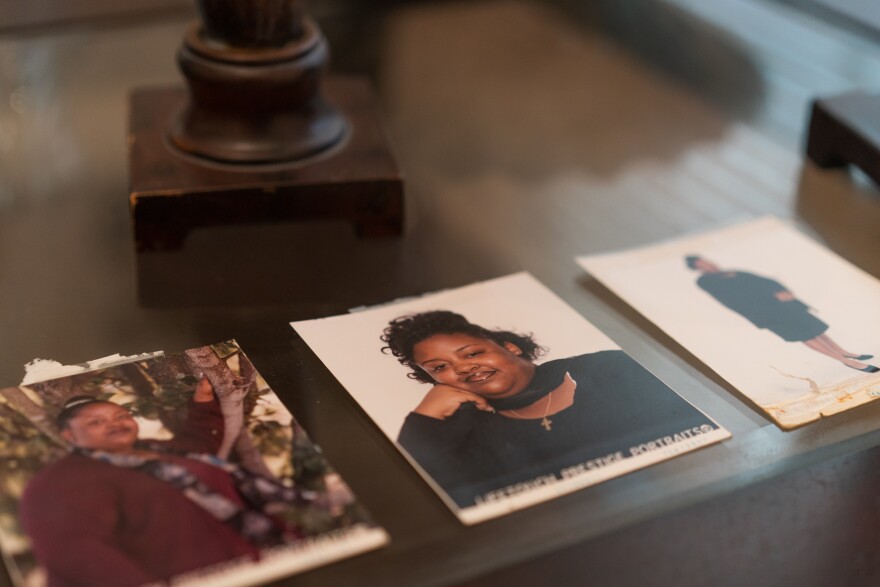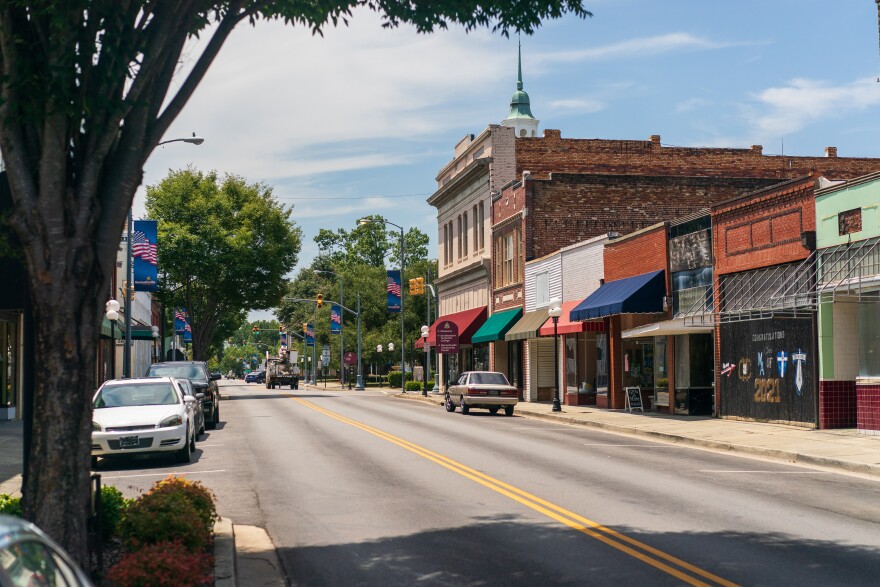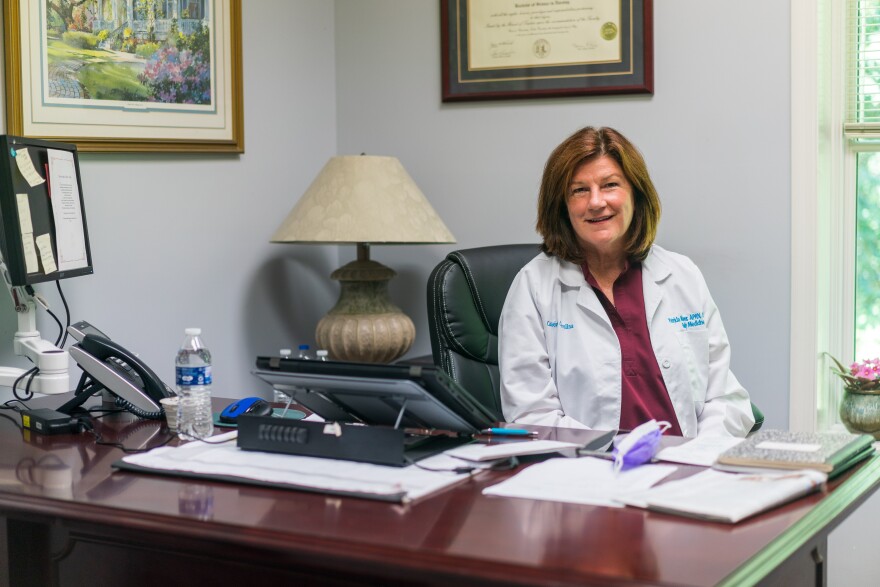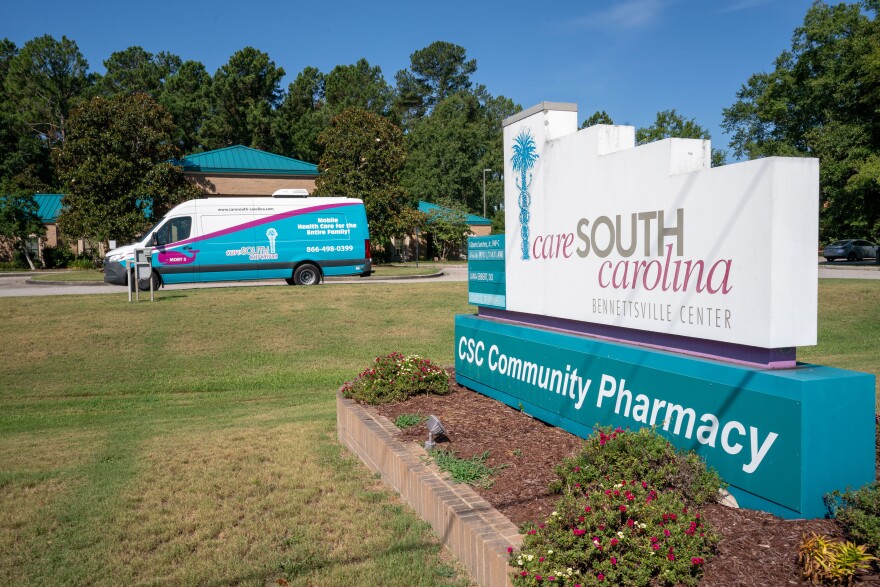Delores Lowery remembers vividly the day in 2016 when she was working in a weaving plant near her home in Bennettsville, S.C., and the world around her seemed to go dim.
She turned to her co-workers. "And I asked, I said, 'Why y'all got it so dark in here? They said, 'Delores, it's not dark in here.' I said, 'Yes it is. It's so dark in here.'"
She landed in the hospital. Her A1C level, which shows the average percentage of sugar in someone's blood over the past few months, was 14.
A reading of 6.5% or higher indicates diabetes.
Lowery's home in Marlboro County is at the heart of what the Centers for Disease Control and Prevention calls the "Diabetes Belt" — 644 mostly Southern counties where rates of the disease are high.
And of those counties, NPR found that more than half have high levels of medical debt. That means at least 1 in 5 people have medical debt in collections.
That's much higher than the national rate, which is 13%, according to the Urban Institute, a social-policy nonprofit. In Marlboro County, 37% of people have medical debt in collections.
NPR measured the overlap of Diabetes Belt counties and high medical debt counties by merging the institute's medical debt database with the CDC's list of Diabetes Belt counties.
Loading...
Institute economist Breno Braga says medical debt, like diabetes, is concentrated in the South.
"The single most important predictor of a county's medical debt is the prevalence of chronic conditions. So it's basically the share of the population that has disease, such as diabetes, hypertension and other types," he says.
That finding is from an analysis conducted by the Urban Institute for KFF Health News and NPR as part of an investigation into medical debt published last year. The investigation found among other things that 100 million people in the U.S. have some kind of health care debt, a burden that can be devastating for people with chronic illnesses such as diabetes and cancer.
Lowery has been dealing with both the medical and financial challenges of Type 2 diabetes, and much more. The years since her diagnosis have been extremely difficult, with one life-changing event having overwhelming health and financial consequences.
In 2017, she came home one day to find her daughter, Ella Shantrica, on the floor, stabbed to death. The body of her granddaughter, 8-year-old Iyana, was found 12 days later in a nearby creek. In February, a man was found guilty in the killings and sentenced to life in prison.

In an interview in the front room of that tidy single-family home in Bennettsville, Lowery says it took some time before she could bring herself to return to the house.
"Every day, 24 hours a day, that incident is in my head," she says. "It will never, ever go away."
She credits her church's pastor with helping her go back to the home, which she shares with her grandson Tyreon, a teenager on the autism spectrum. With her daughter gone, Lowery says she is Tyreon's sole caregiver.
Paying for diabetes care along with bills for food and housing has been a constant financial strain that eventually put her in debt.
"The cost of living was so extremely high in trying to raise my grandson that I just got behind," she says.
She's not alone. In addition to NPR's findings, research from the American Diabetes Association says people with the disease have more than twice the medical expenses annually as those without the disease.
"Because diabetes is a chronic illness, there are always six-month appointments," says Donna Dees, who lives in Georgia and was diagnosed with Type 2 diabetes in 2008. "Every six months, go to the doctor, you've got lab work. So that's how the costs keep building up and building up."
Dees built up thousands of dollars in medical debt and got help from RIP Medical Debt, a nonprofit group that says it has wiped out more than $8 billion in medical debt.
Lowery will tell you that she gets high-quality and compassionate health care from a local provider. But the financial challenge of living with diabetes has put her health into decline.
A drug that once helped her, Ozempic, is now too costly for her.
She says the medicine had been helping bring her diabetes under control. She was getting it delivered to her home, but she didn't meet her copays and the bills piled up as unpaid debt.
Soon, the deliveries stopped and Lowery tried to renew the prescription at the local pharmacy.
"I went to get it and the woman told me, 'I don't think you're going to be able to afford this.' I said, 'Why not?' She said, 'Because it's seven hundred and some dollars.'"

Worse, as the drug's profile skyrocketed in recent months as a "Hollywood" treatment for weight loss, demand increased and a shortage developed.
Lowery said earlier this year that she hadn't been able to get Ozempic for several months and that her diabetes was getting worse. Her insurance company has been no help.
"Nobody is willing to work with me with Ozempic. I don't know what to do," Lowery says. "They won't send me the medicine."
She and her provider even talked about getting physician samples, but given Ozempic's growing popularity, that didn't work.
A changing economy
In Lowery's hometown, others are struggling too.
More than 1 in 3 residents of the surrounding county have medical debt in collections, and 1 in 3 live in poverty.
It wasn't always this way, locals tell NPR. The area once hummed with manufacturing companies, restaurants and other amenities. There were plenty of good jobs to go around.
But one by one, employers moved out. Today, downtown Bennettsville is pretty quiet. South Carolina as a whole has nearly 100,000 fewer manufacturing jobs than it did in 2000.

"Bennettsville used to be a more thriving community years ago," says Lowery's health care provider, nurse practitioner Pat Weaver. "With a lot of our plants leaving for, you know, overseas in the last 15-20 years really made a devastating impact. We used to have a hospital here and now we no longer have that. It is very poor."
Weaver works for CareSouth, a nonprofit health center that has a federal government designation as a safety net provider.
As she walks the halls of the clinic, checking on colleagues and patients, she says that of the 3,300 appointments she takes every year, more than 90% of them have Type 2 diabetes.
She and others point to Bennettsville's changing economic fortune as a source of health problems in the community. Half the households in the city have an income less than $32,000.
She says lower-income residents often can't or don't choose the kinds of healthy meals that would help them control their diabetes.
"The fast foods don't help at all, and a lot of people just eat it every day, and that's a problem. It truly is," Weaver says. "But we have programs to help them. We even have a program where we take patients to the grocery store and we teach them what to buy."
CareSouth takes other steps, too, to fight the effects of poverty and disease in Bennettsville. The center has a sliding fee scale based on ability to pay and an in-house pharmacy that uses a federal program to keep drug prices down.
For Lowery, having a medical provider like Weaver has been a lifeline. "She's seen me through so much," Lowery says. "She tried different medicines to get my diabetes intact."
Finding Weaver came at a time when her family's murders threw her into depression, her finances spiraled out of control, and her diabetes worsened. Weaver, she says, helped get her into counseling.
"When she found out what had happened, I honestly believe in my heart that she cried just like I cried," Lowery says. "She did so much for me."
South Carolina's choice on Medicaid
While there is no easy solution for Lowery, who is over 65 and on Medicare, the Urban Institute and others say a simple policy change could prevent others from getting to such a difficult stage in their disease and finances: Expand Medicaid.
"Seventy-nine out of the 100 counties with the highest levels of medical debt are in states that have not expanded Medicaid under the ACA," the Urban Institute's Braga says.
The ACA is the Affordable Care Act, also known as Obamacare, which offered states the option to expand their health insurance programs for the poor.
South Carolina is one of 10 states that have declined, and where NPR identified more than two dozen counties that fall within the Diabetes Belt and have high rates of medical debt. There's evidence from other states that people became healthier and owed less money to medical providers after Medicaid expansion.

A Boston University researcher looked at health centers just like CareSouth — more than 900 of them serving nearly 20 million patients.
The centers in states that did expand Medicaid reported better diabetes control than those in states that didn't expand the program, and the effect was quick — within three years of the expansion.
Those improvements happened consistently among Black and Hispanic patients, who have higher rates of diabetes.
A study in Louisiana found that people who gained Medicaid coverage after an expansion there had reduced medical debt.
An eye on the future
Lowery says going forward she will continue to rely on her faith and her church community to help her through the tough times.
Still, she worries about the possible worsening of her diabetes and the financial stress of daily life.
"I wish things would get better," she says. "I think I would sleep a little better, because sometimes it's kind of hard for me to try to keep some food on the table."
This story was edited by Robert Little and Kamala Kelkar. It was produced by Meg Anderson. Photo editing by Virginia Lozano. Copy editing by Pam Webster.
Copyright 2023 NPR. To see more, visit https://www.npr.org.






